Harmful Impact of Synthetic Fertilizers on Growing Agriculture and Environment
CDeepali Chittora1*, Tahira Parveen1, Jyoti Yadav1, Bhanu Raj Meena2, Tripta Jain1 and Kanika Sharma1
1Microbial Research Laboratory, Department of Botany, University College of Science, Mohanlal Sukhadia University, India
2Ramjas College, Delhi University, India
Submission: September 01, 2023; Published: November 07, 2023
*Corresponding author: Deepali Chittora, Microbial Research Laboratory, Department of Botany, University College of Science, Mohanlal Sukhadia University, Udaipur, Rajasthan, 313001, India, Email: deepalichittora@yahoo.com
How to cite this article: Deepali Chittora, Tahira Parveen, Jyoti Yadav, Bhanu Raj Meena, Tripta J, et al. Harmful Impact of Synthetic Fertilizers on Growing 002 Agriculture and Environment. Glob J Pharmaceu Sci. 2023; 11(1): 555804. DOI: 10.19080/GJPPS.2023.11.555804.
Abstract
Soil provides essential environmental benefits for life as well as crucial for nutrition and survival of plants. Management of soil health is a critical practice for the preservation of biodiversity and to ensure long-term agricultural production. Scientific management of soil health is an important step for ecosystem sustainability. Some of the important factors like physicochemical and biological parameters that influence soil health. Fertilizers are heavily used in modern farming practices to control unavoidable challenges being faced in Agriculture. Nonetheless, they remain critical tools for global food safety.
Sustainable agriculture practices have been used on a global scale by reducing the negative consequences of chemical fertilizers because they drop in soil organic content as well as decline soil quality. They also harden soil, reducing soil fertility, depleting vital soil mineral nutrients, polluting air, water and soil all of which poses serious environmental hazard. Microbial activity in the cropping system has become low due to the application of chemical fertilizers alone. Regular application of chemical fertilizers can alter soil pH, increase resistance in pests, acidification of soil crust resulting in decreased organic matter and stunted plant growth. Hence, Long-term persistence of chemical fertilizers in the soil harms the biodiversity of soil. Present review paper deals with functioning and role of mineral elements in plant growth and development. Various types of organic and synthetic fertilizers are involved in fulfillment of basic needs of plants. Soil with poor nutrient content needs different types of fertilizers for regulation of physiochemical cycle of plants. The literature reviewed information suggested that our agriculture sector has not been dependent on synthetic fertilizers for plant growth and development i.e., directly linked with the crop productivity at industrial level. Chemicals associated synthetic fertilizers have been harmful for plant health and this will lead to drastic health damaging effect on new generations. In this way we again need to focus on development of natural fertilizers with their environmentally friendly inputs and health promoting activity.
Keywords: Soil health; Chemical fertilizer; Soil organic matter; Environmental risks; Organisms; Microbial activity
Introduction
Pesticides and fertilizers are supplied in soil to fulfill the need of vital plant nutrients. They are used for preservation of ecological balance and soil biodiversity must be addressed in order to meet the world’s expanding food demand. They have been used in modern agriculture for enhancement and consistency agricultural productivity. But certain drawbacks are associated with the continuous use of chemical fertilizers such as the threat to human and environmental health [1,2].
Crop cultivation requires macro and micronutrients like nitrogen, phosphorus and sulfur for their growth and development. During the period of repeated crop harvesting and cultivation, the soil nutrient level decreases and such nutrients are not recycled back to the soil [3].
Therefore, vital nutrient requirements are compensated either through the natural process of decomposition of dead plants and animals; nutrients extracted from dead organisms revert to soil, or by adding fertilizers [4].
According to the soil science society of America, “any organic or inorganic material of natural or synthetic origin, other than liming materials i.e., added to soil to supply one or more essential plant nutrients to the growing of plants are considered as fertilizers” [5].
Fertilizers are decomposable materials used for the addition of nutrients to the soil by maintaining soil fertility and increasing plant growth. Nowadays, fertilizer has become crucial to recent agriculture to nourish the rising inhabitants. Fertilizers contain minerals that support the growth of soil microflora, particularly microorganisms for direct uptake of nutrients to the growing plantlets. This important feature of fertilizers can help fulfill the nutritional requirements of starving people and also controls the death arise by food starvation in a different area of the globe [6,7].
Mainly fertilizers are available in natural and chemical forms. Natural fertilizers are made from organic materials that benefit both plants and soil. Organic fertilizers are made from natural sources such as plant and animal parts. Emerging microorganisms for sustainable agricultural development include cyanobacteria, earthworms, and other decomposing organisms [8,9]. These organisms are useful in the production of inexpensive and environmentally favorable biofertilizers. They can help plants with nitrogen deficit, soil aeration, water holding capacity, and vitamin B12 supplementation. In the rice crop cultivation area, the most efficient nitrogen-fixing cyanobacteria are Nostoc linkia, Anabaena variabilis, Aulosira fertilisima, Calothrix sp., Tolypothrix sp., and Scytonema sp. [10]. Their applications are also reported in barley, oats, tomato, radish, cotton, sugarcane, maize, chili and lettuce [11-13].
The importance of biofertilizer preparation includes:
a) Maintain porosity of soil and produce adhesive agents
b) Secretion of Plant hormones (such as auxin, gibberellins, etc.), vitamins, and amino acids
c) Enhance the water holding power of soil for improving the texture and consistency of soil
d) Increase in soil biomass after death and decomposition of plant parts or dead forest animals or biofertilizer organisms.
e) Reduce soil salt concentration
f) Controls weed growth
g) Availability of soil phosphate through organic acid excretion.
h) Efficient absorption of heavy metals [10,14,15].
Chemical fertilizers are usually readily available, and accessible in greater amounts, increasing crop yield with expensive affairs. Certain drawbacks associated with the overuse of chemical fertilizers are reducing soil porosity, root burn, reducing water holding for the plants, killing soil-friendly microorganisms, reducing soil fertility, disturbing soil pH, and also causing air and water contamination, making them dangerous to human health and the environment. The use of chemical fertilizers regularly depletes vital soil nutrients and minerals that are naturally present in productive soil. Chemical fertilizers constitute a major threat to the balanced and long-term growth of the plant and its connected ecosystem. Several scientists and researchers deeply discussed the best use of organic fertilizers as a solution to avoid soil pollution and other environmental hazards caused by the overuse of chemical fertilizers [16,17]. The harmful effects of chemical fertilizers have posed a severe threat to the environment and the quality of vegetables, crops, fruits, etc. Now, organic or natural fertilizers might be the right solution for eco-friendly and sustainable agriculture practices at the commercial level [18].
Fertilizers
Fertilizers are organic substances with different nutrients and minerals used in the agriculture field to maintain soil quality and improve the yield of plants. It is one of the important components along with water and soil, for healthy crop growth and development [19].
Based on their origin fertilizers may be classified in the following two ways:
a) Natural fertilizers are employed without any modification.
b) Manufactured fertilizers are produced in the laboratory through several steps of processing.
Manufactured fertilizers may be classified as:
a. Processed Natural Fertilizer- Produced by decomposition of organic material e.g. vermicompost.
b. Synthetic Fertilizer- classified into two types:
i. Agricultural
ii. Horticultural fertilizers.
Only a few macronutrients are commonly found in agricultural fertilizers. These are primarily used in agriculture. They are normally expected before or after seeding [20,21].
Horticultural fertilizers are made up of many of the same ingredients as agricultural fertilizers, as well as a few others, to provide well-balanced fertilizers with micronutrients [20]. Watersoluble (rapid release) or comparatively insoluble horticultural fertilizers are available (controlled release). Controlled release, sustained release, and timed-release fertilizers are meant to be applied every 3-6 months, depending on watering, growth rates, and other factors, but water-soluble or rapid release fertilizers must be applied at least every 1-2 weeks in excess watering situations. Horticultural fertilizers, unlike agricultural fertilizers, are sold directly to customers and are part of the retail sector. They’re used in houses, gardens, and farms of many kinds. Fertilizers, on the other hand, can be classed according to the origin of their ingredients [22,23].
This means fertilizers can be one of two types:
a. Inorganic - made up of simple inorganic compounds or minerals that are normally extracted from the ground and used as a single mixture.
b. Organic - derived from a live entity such as a plant or animal [24,25].
Plant Nutrition
Chemical fertilizers are the main source of macronutrients and micronutrients for plant’s growth and development. In addition to three prime elements i.e., oxygen, carbon, and hydrogen, plants need a sufficient amount of nutrients [26,27].
These nutrients are classified as primary nutrients, secondary nutrients, and micronutrients (Figure 1). Plants’ nutritional requirements are divided into three categories:
a. Primary macronutrients: These are large-scale nutrients that plants require. Carbon (C), Hydrogen (H), Oxygen (O), Nitrogen (N), Phosphorus (P), and Potassium (K) are the six macronutrients (K).
b. Secondary macronutrients: Plants require a large number of secondary macronutrients, although not as many as primary macronutrients. Calcium (Ca), Sulfur (S), and Magnesium (Mg) are the three (Mg).
c. Micronutrients: Plants require very little amounts of them. These micronutrients are just as important as macronutrients. Trace elements are another name for them. Iron (Fe), Molybdenum (Mo), Boron (B), Copper (Cu), Manganese (Mn), Zinc (Zn), and Chlorine (Cl) are seven such micronutrients (Cl).
d. Other nutrients like silicon (Si), cobalt (Co), and selenium (Se).
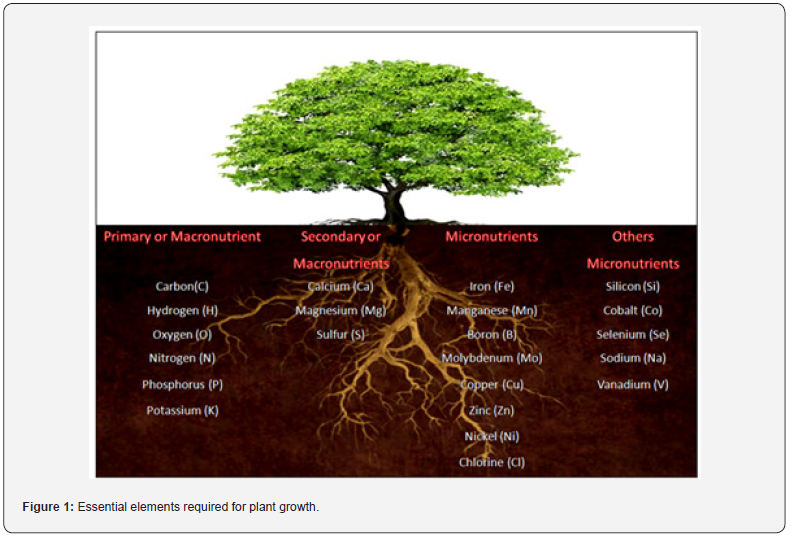
The six basic macronutrients are needed by all plants. Plants’ micronutrient needs can differ. Some plant kinds may not require a specific micronutrient, while others may require more. Plants absorb carbon, hydrogen, and oxygen from the air or water to suit their needs. They get their nutrients from the earth or the leaves by photosynthesis [23] (Table 1).
Types of Chemical Fertilizers
Fertilizers may be defined as materials having a definite chemical composition with a higher analytical value and capable of supplying plant nutrients in available forms. Usually, fertilizers are inorganic (except for Urea and Ca (CN)2 (calcium cyanamide) and solid organic nitrogenous fertilizers). They are obtained from different industries that have less residual effect [27] (Table 2).
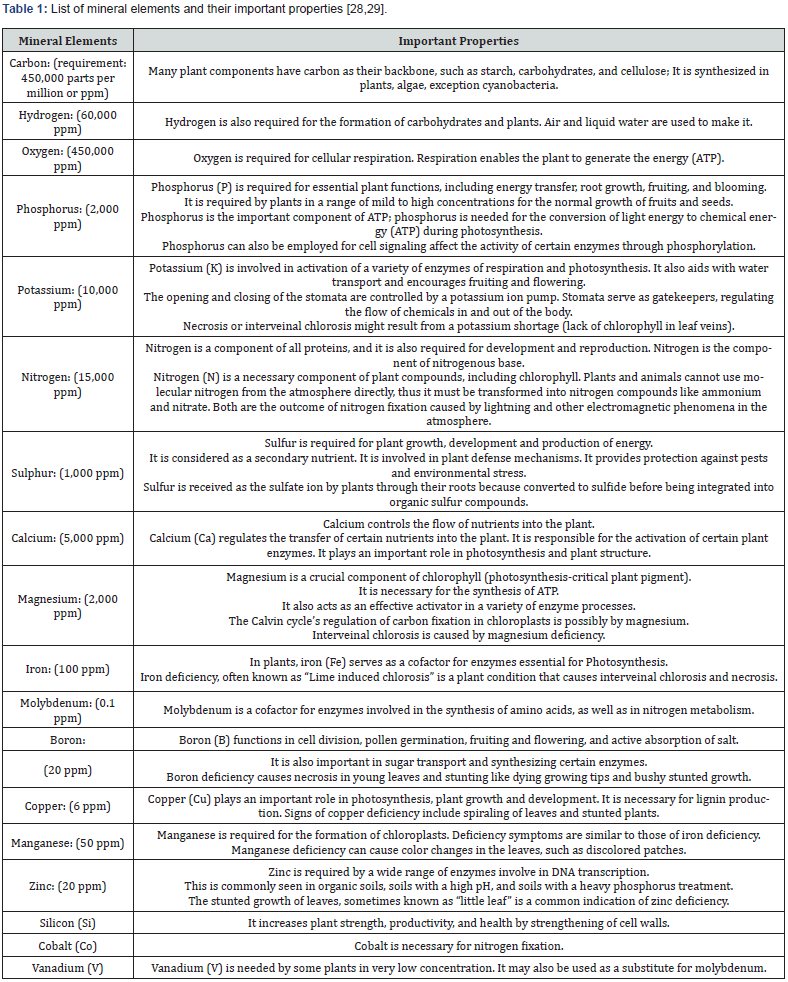
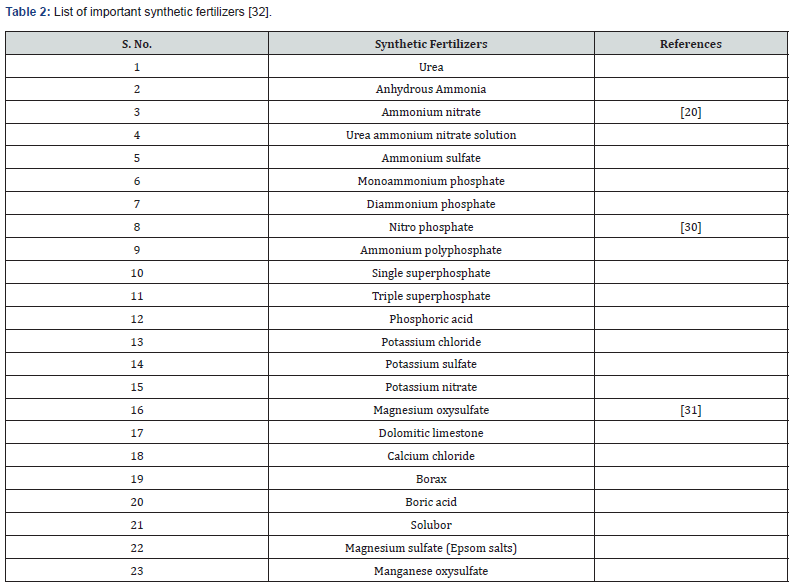
Chemical fertilizers are divided into three types based on the primary nutrient requirements of plants. Nitrogenous fertilizer, phosphorus fertilizer, and potassium fertilizer are the three types. Chemical fertilizer consists of elements such as nitrogen, potassium, and phosphorus. These are used for increasing the productivity of land [33,34] (Table 3).
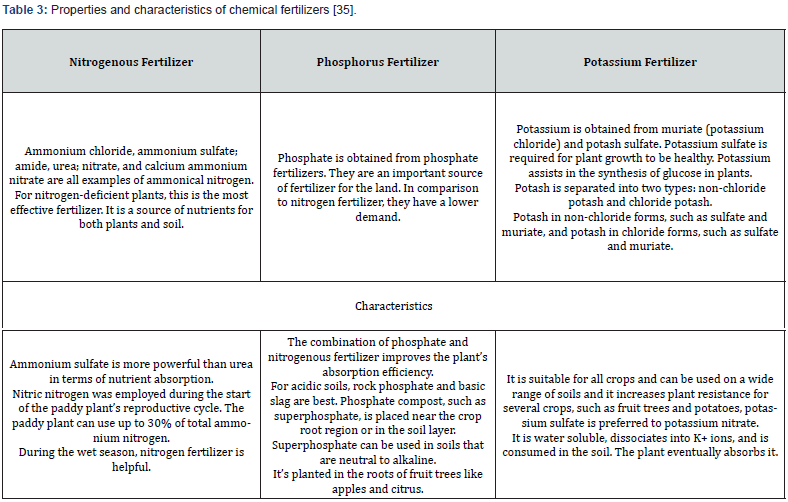
Advantages of chemical fertilizer
a. Chemical fertilizers are employed to restore soil fertility.
b. Fertilizer improves nutrient status and the environment of the soil.
c. It enhances the power of stability in plants against wind and natural disasters.
d. It increases the growth rate and crop yield.
e. Plants get all the nutrients from chemical fertilizer in equal proportion.
f. Chemical fertilizers are water-soluble; they can be absorbed readily.
g. The unnecessary component is not found in chemical fertilizer.
h. Improve and enhance plant growth and development.
1.1. Drawbacks of chemical fertilizer
i. The quality of soil and plant health will be affected by improper use of the chemical.
ii. It contains some elements that disturb the soil properties such as soil pH and water holding capacity.
iii. It is needed in excess amount in agriculture and is very costly for poor farmers.
iv. It decreases the excretion of nitrate through plants into the soil for the improvement of soil microflora.
v. It spoils the organization and texture of the soil due to the absence of organic material.
vi. Soil-dwelling organisms earthworms make the soil fertile are also destroyed due to improper application of chemical fertilizers.
vii. Some nitrogen fertilizer is toxic to both animals and humans [34].
Differences in Natural and Synthetic Fertilizers
Plants and soil benefitted from natural fertilizers made from organic sources. Plants wouldn’t be burnt or harmed by it. Natural fertilizers come from organic sources like compost, bat guano, manure, seaweed, blood meal, and plant and animal components and leftovers. Naturally produced nutrients may encourage beneficial soil microorganisms and enhance the soil’s structure and texture. In order for plants to access simple forms of nutrients, complex organic compounds must first be converted by soil bacteria. The macro- and micronutrients that are typically lacking in synthetic fertilizers can be provided by organically generated fertilizers in accordance with the nutritional needs of plants [36,37].
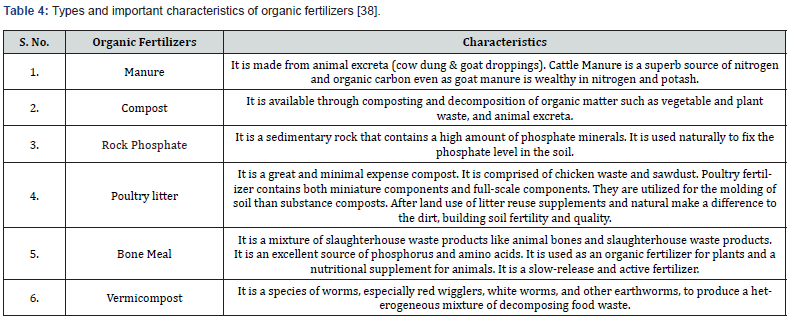
(Source 44)
Nitrogen, phosphorous, and potassium levels in naturally produced fertilizers are typically lower than those in synthetic fertilizers, yet they still need to nourish plants (Table 4). Plants have no mechanism to distinguish between organic or synthetic fertilizers. They are quick boosters of nutrients and responsible for the fast growth of plants. They are also improving soil texture and long-term soil fertility. Synthetic Fertilizers are “Man made” inorganic compounds - usually derived from byproducts of the petroleum industry. Synthetic fertilizers are water-soluble and well-known for being fast-acting. They are available in a variety of forms such as liquid, pellet, granules, and spikes. So, they are easily absorbed by plants. Examples of synthetic fertilizers are ammonium nitrate, ammonium phosphate, superphosphate, and potassium sulfate [38]. Synthetic fertilizers do not support microflora present in the soil. The application of a synthetic fertilizer kills a significant percentage of beneficial microorganisms. These tiny creatures are responsible for breaking down organic matter into a stable alteration for improving soil quality and fertility. It is short-lived, which can cause rapid growth at the expense of developing a strong root system. It may give results in 1–2 weeks [39] (Table 5).
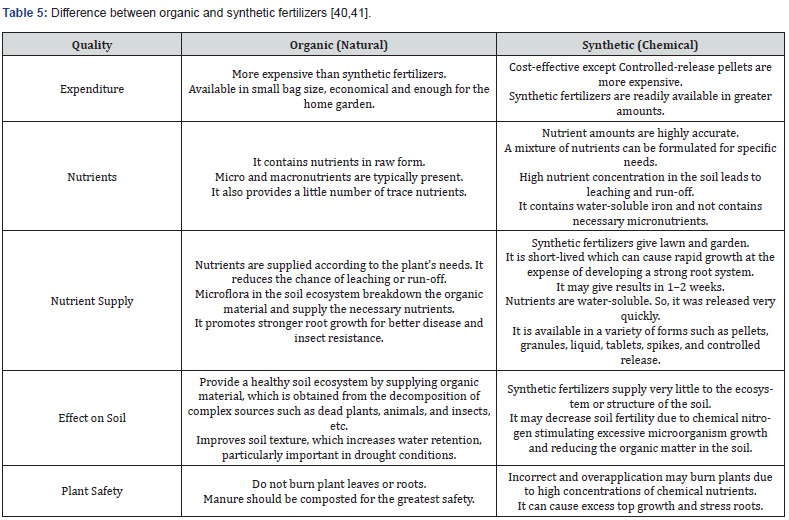
(Source 40,41)
Effects of Synthetic Fertilizers on Plant Nutrition and Health
For appropriate growth and development of plants require 16 key nutritional elements in which 13 elements are provided by soil. Primary nutrients include nitrogen, phosphorus, and potassium (NPK), which are required in the largest proportions [13]. Continuous crop cultivation in the same soil has resulted in the depletion of nutrients stored in the soil. This is controlled by the supply of chemical fertilizers (NPK) into the cultivated soil.
Successive increase in population, rising food demand in near future resulting in consumption of chemical fertilizer has continuously increased with time. Several reports are available on the use of chemical fertilizers at the global level. The consumption of fertilizer has increased for arable and permanent crop areas from 79.29 tones/1000 Ha in 2002 to 98.20 tones/1000 Ha in 2010. The demand for total fertilizer has been increasing further at 1.9 % per annum from 2012 to 2016. According to FAO, China and India is the world leading consumer of chemical fertilizers while the highest production of the same is reported in China, USA, and India (FAO 2012). So, fertilizers may be seen as a requisite part of modern agriculture [42,43].
Long-term application of NPK-based fertilizers has a significant impact on soil biochemical properties, which leads to microbial population changes. Due to the long-term application of fertilizer in a range of crops such as wheat and corn, changes in soil organic carbon, nitrogen concentration, pH, and moisture alter nutritional availability to microorganisms [3]. In contrast to chemical inputs, natural biofertilizers positively impact soil characteristics and functions. These natural inputs are more likely than chemical fertilizers to increase organic carbon and nitrogen content, resulting in greater microbial populations (Figure 2).
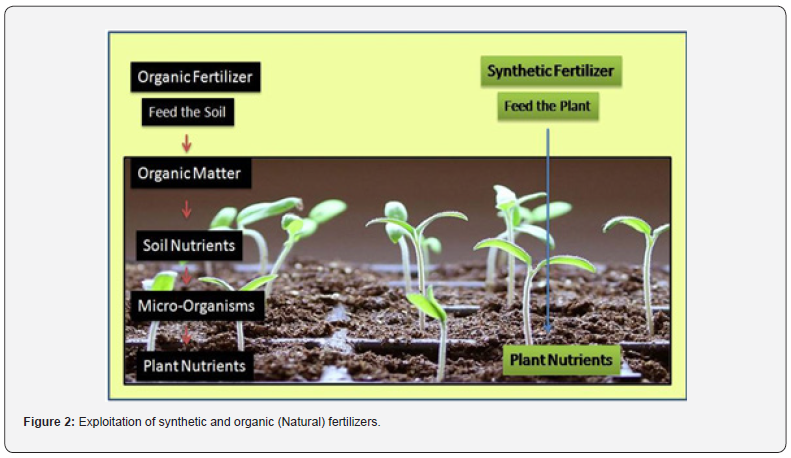
A sufficient supply of key minerals and nutrients is critical for soil fruitfulness and vegetation. Excessive fertilizer usage generates a nutrient supply imbalance in the soil, resulting in continuous soil deterioration. Continuous application of Chemical fertilizers speeds up plant growth resulting in poor root and stem development, as well as nutrient-deficient crops and fruits. In these circumstances, the chances of survival of growing crops are lower and more vulnerable to the attack of pests and associated diseases. Furthermore, chemical fertilizers prevent crops from getting enough water, resulting in root or fertilizer burn [44]. The major drawbacks of Synthetic fertilizers are hazardous for land fertility and their worth. Thus, Organic (natural) fertilizers can help improve the quality of soil fertility and enrich new minerals such as nitrogen, carbon, hydrogen, phosphate, sulfur. While synthetic fertilizer is to harm soil fertility and affects humankind [45,46].
Conclusion
Applications of chemical fertilizer are one of the most serious consequences of Environmental deterioration. Chemical fertilizers are the most essential component of farmed fields. These agricultural practices have been significantly impacting soil quality. Excessive use of chemical fertilizer resulted in massive soil pollution. Chemical fertilizers may harm soil attributes, nutrient content, dominant soil species, structural and functional diversity of microbial communities, soil enzyme activity and many other factors [8].
It may be inferred that the use of chemical fertilizers in excess amounts for an extended period has a variety of unhelpful impacts on the soil micro-flora of agricultural ecosystems. Organic fertilizers have been established as favorable soil amendments that improve the overall quality and fertility of the soil. The applications of organic (natural) fertilizer have contributed to sustainable agricultural practices.
Recently, bio-fertilizers have emerged as an alternative to synthetic fertilizers. They have the potential ability to utilize CO2, water, and nutrients to convert solar energy into biomass. The overall study stated that biofertilizers can be utilized for improving the quality of food products, physicochemical properties of soil, controlling soil-borne diseases, added organic matter, release growth-promoting substances, solubilize the insoluble phosphates, use as nutraceuticals, and also applied in pharmaceuticals. Hence, biofertilizers prepared from organic compounds are economical and environmentally friendly. Hence, organic fertilizers are drawing better inputs in the agriculture field because they are commercial as well as environmentally pleasant options to move forward with a sustainable approach.
Conflict of Interest
The authors have no affiliation with any organization with a direct or indirect financial interest in the subject matter discussed in the manuscript.
Acknowledgment
We are highly thankful for the ministry of education and SPDRUSA Rajasthan under the RUSA-2.0 project.
References
- Mazid M, Khan TA (2015) Future of bio-fertilizers in Indian agriculture: an overview. International Journal of Agricultural and Food Research 3(3).
- Patil HJ, Solanki MK (2016) Microbial inoculant: modern era of fertilizers and pesticides. In Microbial inoculants in sustainable agricultural productivity Springer, New Delhi. pp. 319-343.
- Ghorbani R, Wilcockson S, Koocheki A, Leifert C (2009) Soil management for sustainable crop disease control: a review. Organic farming, pest control and remediation of soil pollutants, pp. 177-201.
- Das AC, Mukherjee D (2000) Soil application of insecticides influences microorganisms and plant nutrients. Appl Soil Ecol 14: 55-62.
- Russell JE (2002) Soil conditions and plants growth. Daya Books.
- Wang MC, Liu YH, Wang Q, Gong M, Hua XM, et al. (2008) Impacts of methamidophos on the biochemical, catabolic, and genetic characteristics of soil microbial communities. Soil Biol Biochem 40(3): 778-788.
- Itelima JU, Bang WJ, Onyimba IA, Sila MD, Egbere OJ (2018) Bio-fertilizers as key player in enhancing soil fertility and crop productivity: a review.
- Saqib S, Nazeer A, Ali M (2022) Catalytic potential of endophytes facilitates synthesis of biometallic zinc oxide nanoparticles for agricultural application. Biometals 35: 967-985.
- Fiza L, Liu Q, Samiah A, Urooj H, Saddam S, et al. (2021) Isolation and characterization of pathogen causing brown rot in lemon and its control by using ecofriendly botanicals, Physiological and Molecular Plant Pathology 114: 101639,
- Chittora D, Meena M, Barupal T, Swapnilb P, Sharma K (2020) Cyanobacteria as a source of biofertilizers for sustainable agriculture. Biochemistry and Biophysics Reports 22(2020): 10073.
- Powlson DS, Gregory PJ, Whalley WR, Quinton JN, Hopkins DW, et al. (2011) Soil management in relation to sustainable agriculture and ecosystem services. Food policy 36: S72-S87.
- Prasad C, Prasad BN (2001) Cyanobacteria as a source biofertilizer for sustainable agriculture in Nepal. J Plant Sci Bot Orient 1: 127-133.
- Thajuddin NG Subramanian (2005) Cyanobacterial biodiversity and potential applications in biotechnology. Curr Sci 89: 47-57.
- Mahmud A, Upadhyay S, Srivastava A, Bhojiya Al (2021) Biofertilizers: A Nexus between soil fertility and crop productivity under abiotic stress. Current Research in Environmental Sustainability.
- Singh SP, Pathak J, Sinha RP (2017) Cyanobacterial factories for the production of green energy and value-added products: an integrated approach for economic viability, Renew. Sustain. Energy Rev 69: 578-595.
- Olatunji O, Ayuba SA (2012) Effect of combined applications of poultry manure and NPK 20-10-10 fertilizer on soil chemical properties and yield of maize (Zea mays). Proceedings of the 35th Annual Conference of the Soil Science Society of Nigeria (SSSN). 7th – 11th March 2011, FeUniversity of Technology Minna.
- Bisht N, Chauhan PS (2020) Excessive and Disproportionate Use of Chemicals Cause Soil Contamination and Nutritional Stress. In: ML Larramendy, S Soloneski, (Eds.), Soil Contamination - Threats and Sustainable Solutions. IntechOpen.
- Lin W, Lin M, Zhou H, Wu H, Li Z, Lin W (2019) The effects of chemical and organic fertilizer usage on rhizosphere soil in tea orchards. PloS one 14(5): e0217018.
- Chen JH (2006) The combined use of chemical and organic fertilizers and/or biofertilizer for crop growth and soil fertility. In International workshop on sustained management of the soil-rhizosphere system for efficient crop production and fertilizer use, Land Development Department Bangkok Thailand 16(20): 1-11.
- Bot A, Benites J (2005) The importance of soil organic matter: Key to drought-resistant soil and sustained food production (No. 80). Food & Agriculture Organization.
- Pettit RE (2004) Organic matter, humus, humate, humic acid, fulvic acid and humin: their importance in soil fertility and plant health. CTI Research 10: 1-7.
- Varadachari C, Goertz HM (2010) Slow-release and controlled-release nitrogen fertilizers. Indian Nitrogen Group, Society,
- Timilsena YP, Adhikari R, Casey P, Muster T, Gill H, et al. (2015) Enhanced efficiency fertilizers: a review of formulation and nutrient release patterns. Journal of the Science of Food and Agriculture 95(6): 1131-1142.
- Senesi N, Loffredo E (2018) The chemistry of soil organic matter. In Soil physical chemistry CRC press, pp. 239-370,
- Shukla R, Sharma YK, Shukla AK (2014) Molecular mechanism of nutrient uptake in plants. International Journal of Current Research and Academic Review 2(12): 142-154.
- Kathpalia R, Bhatla SC (2018) Plant mineral nutrition. In Plant physiology, development and metabolism, Springer, Singapore, p. 37-81.
- Reddy CV, Kashyap L, Alok T (2017) Effect of 14-year long term fertilizer management on soil organic carbon stock, carbon sequestration rate and nutrient balances in Vertisols. Int J Curr Microbiol App Sci 6(7): 895-902.
- Maathuis FJ, Diatloff E (2013) Roles and functions of plant mineral nutrients. Plant mineral nutrients 953: 1-21.
- Roy RN, Finck A, Blair GJ, Tandon HLS (2006) Plant nutrition for food security. A guide for integrated nutrient management. FAO Fertilizer and Plant Nutrition Bulletin 16: 368.
- Savoy H (2009) Fertilizer and their use. Agricultural Extension Service. The University of Tennessee, p. 1-23
- Kant S, Kafkafi U (2013) Fertigation. In: Reference module in earth systems and environmental sciences.
- Iqbal S, Riaz U, Murtaza G, Jamil M, Ahmed M, et al. (2021) Chemical fertilizers, formulation, and their influence on soil health. In: Microbiota and Biofertilizers Springer, Cham, p. 1-15.
- Niyi SO (1981) Effect of long term NPK application on secondary and micronutrient content of cofffea carephora. Plant and soil 60: 477-480.
- Pahalvi H, Majeed L, Rashid S, Nisar B, Kamili A (2021) Chemical Fertilizers and Their Impact on Soil Health.
- Pahalvi HN, Rafiya L, Rashid S, Nisar B, Kamili AN (2021) Chemical fertilizers and their impact on soil health. In: Microbiota and Biofertilizers, (Volume 2), Springer, Cham, p. 1-20.
- Ahmad F, Ahmad I, Khan MS (2008) Screening of free-living rhizospheric bacteria for their multiple plant growth promoting activities. Microbiol Res 168: 173-181.
- Fiza L, Hussain MMF, Samiah A, Urooj H, Jianxin S, et al. (2021) PacBio Single-Molecule Long-Read Sequencing Reveals Genes Tolerating Manganese Stress in Schima superba Saplings. Frontiers in Genetics.
- Brookes P (2001) The soil microbial biomass: concept, measurement and applications in soil ecosystem research. Microbes Environ 16: 131-140.
- Novia D, Rakhmadi A, Purwati E, Juliyarsi I, Hairani R, et al. (2019) The characteristics of organic fertilizer made of cow feces using the Indigenous Micro-Organisms (IMO) from raw manures. In IOP Conference Series: Earth and Environmental Science. IOP Publishing 287(1): 012025.
- Bisht N, Chauhan PS (2020) Excessive and Disproportionate Use of Chemicals Cause Soil Contamination and Nutritional Stress. In: ML Larramendy, S Soloneski (Eds.), Soil Contamination - Threats and Sustainable Solutions. IntechOpen.
- Dias N, Bandara MACS, Munaweerage TP, Shantha WHA Commercial organic fertilizer production.
- Coleman E (2018) The new organic grower: A master's manual of tools and techniques for the home and market gardener. Chelsea Green Publishing.
- Sharma A, Chetani R (2017) A review on the effect of organic and chemical fertilizers on plants. IJRASET 5(2): 677-680.
- Francis CA, Harwood RR, Parr JF (1986) The potential for regenerative agriculture in the developing world. American Journal of Alternative Agriculture 1(2): 65-74.
- Kumar S, Dahiya R, Kumar P, Jhorar BS, Phogat VK (2011) Long-term effect of organic materials and fertilizers on soil properties in pearl millet-wheat cropping system. Ind J Agric Rese 46(2): 161-166.
- Yadav AK, Gurnule GG, Gour NI, There U, Choudhary VC (2022) Micronutrients and Fertilizers for Improving and Maintaining Crop Value: A Review. International Journal of Environment, Agriculture and Biotechnology 7: 1.






























